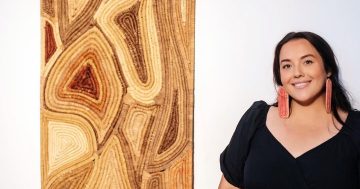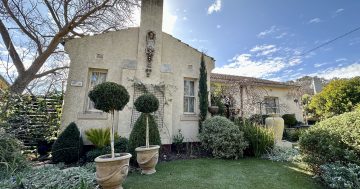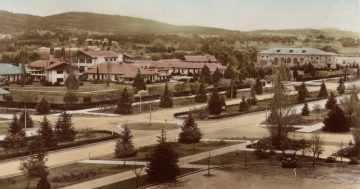
Jessika Ahlgren and Tim Hubbard outside their newly restored home, Tea Gardens, in the centre of Ngunnawal. Photo: Sally Hopman.
Would it shock you to learn that one of Canberra’s oldest homes is in one of the Territory’s newest regions?
Known as ‘Tea Gardens’, the original red brick residence has been home for Jessika Ahlgren and Tim Hubbard and their “Brady Bunch” family of six since 2020.
They have spent the past two years restoring the six-bedroom home on the more than 2000-square-metre block in Ngunnawal. Now they want to uncover its past. They’ve done their own detective work, invited historians for their input and scoured old documents for any hints about the property, which at one time was a horse riding centre.
It is not heritage-listed because of the significant changes made to the house back in the 1960s, but they’re keen to find out as much as they can about its former lives.

Tea Gardens has been transformed into a warm family home, with many of the original features, like the floorboards, given a new lease of life. Photo: Sally Hopman.
One thing’s for sure, it has become “home” for them in every sense of the word, but it wasn’t love at first sight for everyone.
When Jessika saw Tea Gardens for sale online back in 2020, she was smitten. Tim, not so much.
“I don’t think I’ve ever felt so excited,” Jessika said when she saw that the house was within their budget.
“I thought, surely there must be rising damp.” There wasn’t.
“I thought there must have been structural issues.” There weren’t.
Tim told Jessika he had called the agent to show him the house.
“I said he didn’t need to see the inside, just make an offer and buy it. Who cares what it looks like? We can fix it,” she joked.
And they did.

A view of the original Tea Gardens homestead from the “backyard” golf course. Does this bring back any memories for you? Photo: Supplied.
Restoration of the home has been a labour of love – and hard work – for the family. They did much of the work themselves but got in experts for the big jobs.
“I’ve always collected old stuff because I like living in older houses,” Jessika said, “but who knew it was going to be in the middle of Gungahlin?
“We got a builder in to do all the doors. He cursed us because all of them were different sizes,” she said. “As in all old houses, nothing was square.
“We did the majority of painting and put the skylights in, but we got some help when we ran out of steam. But the most important thing for us has been to keep the character of the house intact.”
The house is on four levels, the lowest overlooking the golf course, so it looks like their backyard goes for miles. They’ve built a sandstone wall around a fire pit, topped with a steel screen that looks like a work of art.
But throughout the restoration process, they constantly came across hints that the house could well be one of Canberra’s oldest.

Jessika Ahlgren and Tim Hubbard on the newly renovated lower level of the house adjacent to the golf course where they’ve put in a sandstone seating area and screen. Photo: Sally Hopman.
“It has been such a joy bringing this place back to life,” Jessika said. “We would now love to find out more about it.”
So far, the family has uncovered some connections to the home’s early owners, thanks to A Short History of Gungahlin by Helen Cooke of the Canberra Archaeological Society.
She writes of Anthony and Catherine Rolfe arriving from Sydney on 12 February 1849 and living temporarily with his brother William in Canberra.
“They selected Portion 123, 320 acres in the Parish of Goorooyaroo at a land sale in Queanbeyan on 20th February 1857 and quickly took up residence, calling their property Tea Gardens.”
The homestead was described as being built of local red brick in the 1860s, possibly replacing an earlier slab or temporary pisé building.

Jessika saw this cabinet in an antique shop and knew it would be perfect for their newly renovated home – even though it wasn’t for sale at the time. Photo: Sally Hopman.
After the death of Anthony and Catherine, their daughter Martha married John Ryan in 1868 and they lived at Tea Gardens until 1916 until it was “acquired for the Federal Capital”. Their son Edward lived there until the 1950s when it was bought by Norman Coulton who significantly increased the size of the house from its original four brick rooms.
The land was bought by the Commonwealth and became a residential riding school called Ginninderra Park on land under lease until it was resumed in the 1990s.
“Local historian Lyall Gillespie has also been really helpful,” Tim said.
“In his notes on the property, the first reference goes back to 15 January 1891, with a ‘Mr Thomas Gribble of Tea Gardens organising a race meeting on the course of his place’.”
This is followed up by a report on the Tea Gardens Home Harvest Races on 3 February 1891. In Yemen’s Directory of Landholders 1900, John Ryan’s Tea Gardens is “shown as growing wheat, maise, barley and other crops, dairy farming and grazing”.
In the Ginninderra Gossip column of the Queanbeyan Age, 24 March 1905, there’s a report of a “social promoted in aid of the Country Stall in connection with the approaching RC Bazaar being held in Mr Ryan’s wool shed, Tea Gardens”.
Do you have memories of Tea Gardens from Canberra’s early days that may help Tim and Jessika fill in the gaps in the history of their home? We’d love to hear from you.




















